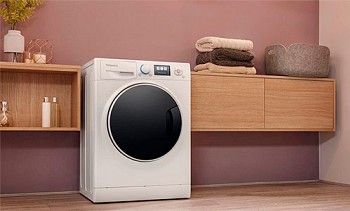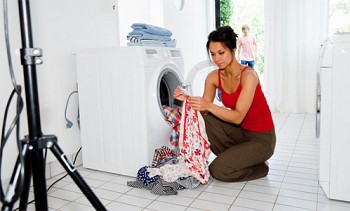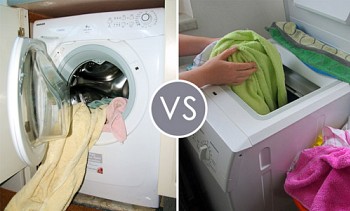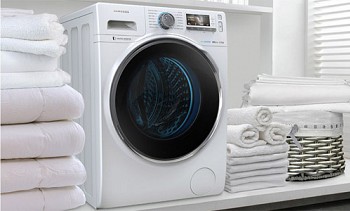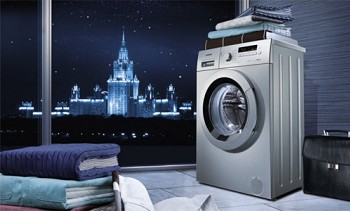Even the most notorious skeptics have finally realized that with an automatic washing machine, everyday life becomes much more comfortable. It is not necessary to prepare for the “big wash” for a long and tedious time - it is quite possible to throw things into the machine as they become dirty, and it quickly and accurately launders and dries them.
So more and more people are acquiring this type of household appliances. However, after the purchase, one question arises - how to connect the washing machine correctly, as well as with minimal effort and finance. It’s not difficult to do this yourself - read on how.
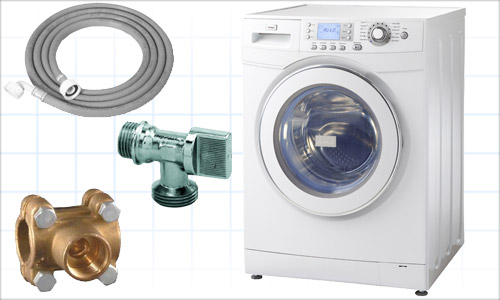
Content:
- Where to put a washing machine
- The washing machine has arrived - we begin to unpack and prepare for installation
- Bring water
- Connecting the washing machine to the sewer
- Video: Connecting a washing machine without running water
- Without electricity, the car will not work
- We put the legs of the machine exactly
- We are testing
- Video: Installing and connecting the washing machine
Where to put a washing machine
Even before the machine in a cardboard box arrives home from the store, it will be necessary to choose a suitable place for it. After all, the difference between automatic machines from those that were used before is that they are stationary devices. If necessary, such a machine cannot be moved from the corridor to the kitchen or to the bathroom - connected to the water supply and sewage system, it has a permanent place of "residence".
Most people traditionally give the washing machine a place in the bathroom. This is understandable - after all, pipes with water pass there, and it is also easy to equip a drain. True, sometimes there is not enough space in the bathroom, and then you need to decide how to connect the washing machine in the kitchen. If there is no suitable corner there, and the hallway has impressive dimensions, you can try a non-standard option - equip a place for a washing machine in the corridor. Closing its walls with a neat cabinet can turn the washing machine into an original and beautiful piece of furniture.
The washing machine has arrived - we begin to unpack and prepare for installation
So, finally, a laundry assistant was bought, the order was delivered, and the movers brought the box into the apartment. Well, now you first need to remove this box. Now we remove the fasteners that fixed the elements of the machine during its transportation, protecting the rotating parts from accidental damage. Fasteners are bars, staples and bolts.
The brackets are located on the back and are intended not only for fixing the electric cord and hose, but also give the necessary rigidity for transportation. The bars are placed between the body of the device and the tank, they are easily removed if the machine is slightly tilted forward. Bolts are on the front, holding the drum. After removal, all these details must be packed and stored - when contacting the service they will be needed.
Keep in mind that after the transportation bolts are unscrewed, the washing machine's tank will hang on the springs. Do not be scared - this is normal. Before connecting the device, you must not forget to insert the plastic plugs that come with the holes in the holes in which these bolts were previously located.

Important: Do not turn on the machine in any case before removing all fastening transportation parts - this may end badly for its drum.
Bring water
When deciding whether to connect the washing machine to the water supply, keep in mind that there are several options for which two things are common: the water pressure in the pipes must be sufficient (usually at least one atmosphere), and this water must be clean.Low pressure can be increased by placing a booster pump in front of the washer, and a filter screen is placed to clean the water.
Now you can consider the options for bringing water to our machine.
Crimp fitting
Taking a flexible hose with a diameter of three quarters of an inch, connect it on one side to the washing machine, and on the other to a separate valve, which will need to be cut into the water pipe using a crimp sleeve (if the metal pipe).

Components of a crimp coupling.
Such a coupling consists of two halves, put on a pipe and tightened with bolts, and a threaded branch, on which a crane is screwed (preferably a ball). For the flow of water in the pipe, drill a hole directly through the put on sleeve.

An example of connecting to a water supply system using a crimp sleeve.
Photo - techno.techinfus.com/en/
Inserting into a metal plastic using a fitting
If the pipes for supplying cold water consist of metal plastic, we use a special tee called a fitting. We cut a piece of pipe in the right place, and insert the fitting into the resulting opening, to which we attach a ball valve. The joints are sealed with rubber cuffs.

Insert into metal with a tee.
Connection with tee
You can use a simpler option - connect the washing machine (again with a flexible hose) to the mixer, or to supply water to the toilet flush tank. The hose should be long enough, and a tee is usually used to connect it. Before washing, the mixer hose will have to be unscrewed each time. This option can be considered rather as temporary, and it does not look very aesthetically pleasing. Connecting the drain tank to the water hose is a practical method, but it can only be used if the washing machine and the toilet are in the same room.

Connecting the washing machine to the inlet of the toilet flush tank.
Photo - gor-servis.ru
Connecting a washing machine without running water
And what if the plumbing in the house is not carried out? It is a pity to refuse such a convenient thing as a washing machine, in the country, for example. Do not worry - you will now learn how to connect a washing machine without running water at minimal cost. All that’s needed is to raise a large water tank to a height of not less than a meter, and preferably higher, and hold a hose from the bottom to the machine’s inlet. This creates the necessary water pressure for its operation. A more expensive way would be to buy a pumping station.
Video: Connecting a washing machine without running water
Connecting the washing machine to the sewer
Pouring clean water is only half the battle. Now we need to decide what we will do with dirty and soapy water remaining after washing. Of course, you need to think about connecting the washing machine to the sewer. This can also be done in many ways.
Flush to the bathroom or toilet
The easiest way is to use dirty hose called a “hook” to drain dirty water directly into the toilet, or into the bath. But at the same time one condition must be met: the top of the hose should be no less than sixty centimeters higher than the washing machine. For this, she has special mounts.

The easiest way to discharge waste water. Photo - techno.techinfus.com/en/
Siphon drain
You can do this: make waste water discharge stationary. To do this, you first need to purchase a special siphon, in which there is an outlet designed for washing machines - now in stores these are on sale. According to the rules, the tap must be above the siphon elbow. If you ignore this rule, or connect the washing machine to the sewage system directly, then dirty water may be sucked into the device. The result is the appearance of an unpleasant odor in it.

Organization of drainage of water from the washing machine through a siphon with a special outlet.
Photo - gor-servis.ru
Sewer drain
However, you can still do without a siphon. If the sewer pipe has a thickness of four to five centimeters, then you can directly install an outlet for the washer on it. In this case, we definitely use a sealant, and we drain the drain hose, curved in the form of the letter S, into the pipe so that it does not touch the surface of the drain water. We have its upper edge no lower than half a meter from the floor.

Drain water into the sewer pipe through a tee with a sealing gum.
Photo - gor-servis.ru
Important: if a check valve is not provided for in the design of your washing machine model, then it must be installed taking into account the limitations of the level at which the drain hose is located (otherwise, the pipe). Typically, the manufacturer indicates the maximum and minimum values of this level.
Without electricity, the car will not work
Well, we brought water, organized a drain, now it remains to bring the power supply. Knowing how to properly connect the washing machine to the mains, you can avoid many unpleasant (and possibly tragic) consequences. Indeed, high voltage coupled with water is a terrible force. Therefore, caution and caution again - these are the main tips when applying current in humid rooms.
To protect your family, be sure to ground the switchboard. The ground bus should be no thinner than three millimeters. We use a three-wire outlet. By the way, if the washing machine will be in the kitchen, it is quite possible to include it in a socket made for an electric stove. If an extension cord is needed for connection, we use only one that has grounding contacts.
The optimal solution is to connect the washing machine with a separate wire leading from the counter. A protective circuit breaker is placed on it. For these works it is better to invite an experienced electrician. If a separate wire is not drawn, use a portable RCD - residual current device.
And further: Never connect the ground to heating radiators, gas and water pipes. This is deadly!
We put the legs of the machine exactly
In order for the new assistant to wash for a long time, without breaking or overloading, a necessary condition is the strict horizontalness of its upper part. In this case, the drum will be located without distortions, rotating smoothly and without shaking at the same time. The maximum deviation from the horizontal, which is acceptable, is only two degrees.
To achieve the desired horizontalness, use the adjustment of the legs of the machine - for all models this adjustment is provided. We check the result using the level, tightening the legs until it is satisfactory. There should not be any rubber rugs, pieces of linoleum and little blocks placed under the legs of the washing machine - the automatic machine is installed directly on the floor, best of all on concrete. It, unlike wood, for example, provides excellent cushioning.

Leveling the legs of the machine.
We are testing
Once again, having carefully examined all the connections and connections, and just in case, having checked the instructions, you can make a trial run. At the same time, we sequentially perform all the necessary operations and check whether everything is happening properly.
First you need to fill the tank of the machine with water, detecting the time of its filling to the mark and checking the data specified in the passport. If at the same time it is discovered that some of the compounds is leaking, it is necessary to drain the water and eliminate the leak. If all is well, you can turn on the car.
After five to seven minutes, the water is heated to the desired temperature. During the operation of the washing machine, no extraneous sounds should be heard - after all, modern devices operate almost silently. If something is grinding or knocking, then it signals a malfunction. Having determined that everything is in order, Next, we will check how the squeezing device works, and then we will test the drain. On this, the performance check of the assistant for washing can be considered complete.
We hope that after reading these tips you can connect the washing machine yourself without much difficulty. After all, this process does not involve any particular difficulties. Good luck
Video: Installing and connecting the washing machine

